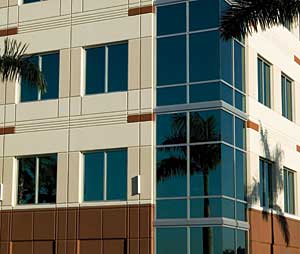How and Why Laminated Glass Solutions Meet Expanding Hurricane Code Requirements
Glazing Recommendations
Glazing recommendations for architectural laminated glass are well established and published by the Glass Association of North America (GANA). The minimum requirements for typical commercial impact resistant glazing applications are 1/2-in or greater glass edge bite, 3/16-in or greater face clearance, and 1/4-in or greater edge clearance. Specific manufacturers may have special requirements regarding fastening, cleaning, spacing and contact with other materials. Because moisture near the laminated glass edge may have a deleterious effect on the adhesion of the glass to the interlayer, weep holes are recommended to prevent the accumulation of moisture in the glass pocket.
 |
| The windows of Cornerstone II office building in Fort Lauderdale, FL. were installed using a laborsaving dry glaxzing system. Courtesy of: DuPont Glass Laminating Solutions |
Glazing Systems Performance
In addition to the laminated glass infill needing to meet impact requirements, the entire glazing system must meet dynamic performance criteria in large and small missile impact and cycle tests in order to manage impact events and loads of significant magnitude such as hurricane force winds. A common glazing solution for surviving the demanding dynamic loads applied to window test specimens is to adhesively bond the laminated glass composite to the supporting structure with a high performing architectural sealant. The design of this glazing detail is critical in order to achieve the maximum capability of the laminated glass infill. In hurricane regions with higher wind load requirements, the glass used in the laminate is required to be heat-treated.
Dry Glazed Systems
The most recent solution known as "dry glazing" uses gaskets in place of adhesives for large missile impact protection. Adopted within the past two years a dry glazed large missile impact system requires the use of a stiff interlayer within the glass laminate in order to limit deflection of the broken laminate during loading. Dry glazed large missile impact systems with laminate infill have been certified to +/- 90 psf for sizes up to 5 feet by 8 feet. Similarly sized laminated insulating glass systems achieve design pressures approximately 50% greater than systems using laminated glazing infill.
Applied to a field installed and glazed fenestration system, dry glazing can result in significant cost savings in labor and materials compared with wet glazed systems. Moreover, replacement of broken laminated glass infill is faster, easier and simpler. Sid Miller, whose company used dry glazing to install windows in the Cornerstone II office building in Fort Lauderdale, reports that in addition to savings in labor-setting the glass and running the gasket can be done at the same time thus eliminating the need for a caulker's return visit-dry glazing gives a more consistent performance since glazing pockets do not need to be cleaned of dust and contaminants.
|










